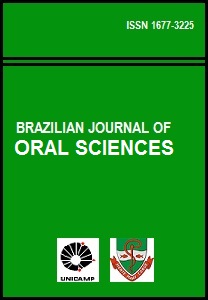Abstract
Hypodontia, the congenital absence of one or a few permanent teeth, is one of the most frequent alterations of the human dentition. Although hypodontia does not represent a public health problem, it may cause both, speech and masticatory dysfunction as well as esthetic problems. Ablation of Lef1 gene in mice causes complete loss of teeth and interferes with the development of other structures induced by epithelial-mesenchymal interaction. In order to further investigate the role of the Lef1 gene in human hypodontia we analyzed the promoter region of the Lef1 gene in 50 subjects with different patterns of hypodontia and 50 control individuals. The analysis of single strand conformation polymorphism (SSCP) did not show any polymorphisms/mutations in the region analyzed.References
Simons AL, Stritzel F, Stamatiou J. Anomalies associated with hypodontia of the permanent lateral incisors and second premolars. J Clin Pediat Dent 1993; 17: 109-11.
Burzynski NJ, Escobar VH. Classification and genetics of numeric anomalies of dentition. Birth Defects Orig Artic Ser. 1983; 19(1): 95-106.
Graber LW. Congenital absence of teeth: a review with emphasis on inheritance patterns. J Am Dent Assoc. 1978; 96: 266-75.
Stock DW, Weiss KM, Zhao-Zhiyong Z. Patterning of the mammalian dentition in development and evolution. BioAssays. 1997; 19: 481-90.
Line SRP. Molecular strategies in the evolution of mammalian dental patterning. Evol. Ecol. 2001; 15: 73-9.
Vastardis H, Karimbux N, Guthua SW, Seidman JG, Seidman CE. A human MSX1 homeodomain missense mutation causes selective tooth agenesis. Nat Genet. 1996; 13: 417-21.
Line SRP. Molecular morphogenetic fields in the development of human dentition. J. Theoretical Biol. 2001; 211: 67-75.
Van Genderen C, RM Okamura, I Fariñas, R-G Quo, TG Parslow, L Bruhn, R Grosschedl. Development of several organs that require inductive epithelial-mesenchymal interactions is impaired in LEF-1-deficient mice. Genes Dev. 1994; 8: 2691-703.
Orita M, Suzuky Y, Sekiya T, Hayashi K. Rapid and sensitive detection of point mutations and DNA polymorphisms using the polymerase chain reaction. Genomics. 1989; 5: 874-9.
Brook AH. A unifying aetiological explanation for anomalies of human tooth number and size. Arch Oral Biol. 1984; 29: 373-8.
Stoy PJ. Taurodontism associated with other dental abnormalities. Dent Pract Dent Rec. 1960; 10: 202-5.
Shape PT. Homeobox genes and orofacial development. Connect Tissue Res 1995; 32: 17-25.
Neubuser A, Peters H, Balling R, Martin GR. Antagonistic interactions between FGF and BMP signaling pathways. Cell. 1997; 90: 247-55.
Peters H, Balling R. Teeth: Where and how to make them. TIG 1999; 15: 59-64.
Kemp TS. Mammal-like reptiles and the origin of mammals. New York: Academic Press; 1982.
Edelman GM, and Gally JA. Degeneracy and complexity in biological systems. Proc. Natl. Acad. Sci. USA. 2001; 98:13763-8.
Stern, D.L. Perspective: Evolutionary developmental biology and the problem of variation. Evolution. 2000; 54: 1079-91.
The Brazilian Journal of Oral Sciences uses the Creative Commons license (CC), thus preserving the integrity of the articles in an open access environment.

